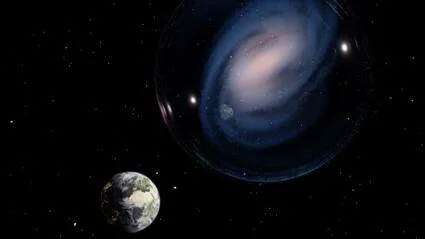The most distant barred spiral galaxy that resembles the Milky Way that has been spotted to date has been found by an international team, led by Luca Costantin at the Centro de Astrobiología in Madrid, using the James Webb Space Telescope.

Artistic representation of the spiral barred galaxy ceers-2112, observed in the early universe. The Earth is reflected on an illusive bubble surrounding the galaxy, recalling the connection between the Milky Way and ceers-2112. Image Credit: Luca Costantin/CAB/CSIC-INTA
It was previously thought that barred spiral galaxies like the Milky Way could not be visible until the universe, estimated to be 13.8 billion years old, reached half its current age.
The study, which was published in Nature, was led by researchers at Spain’s Centro de Astrobiologa.
This galaxy, named ceers-2112, formed soon after the Big Bang. Finding ceers-2112 shows that galaxies in the early universe could be as ordered as the Milky Way. This is surprising because galaxies were much more chaotic in the early universe and very few had similar structures to the Milky Way.
Alexander de la Vega, Study Co-Author and Postdoctoral Researcher, Department of Physics and Astronomy, University of California, Riverside
Ceers-2112 features a bar in the middle. A galactic bar, according to De la Vega, is a structure comprised of stars that exist within galaxies. He claims that bars can be found in non-spiral galaxies, but they are extremely rare.
“Nearly all bars are found in spiral galaxies. The bar in ceers-2112 suggests that galaxies matured and became ordered much faster than we previously thought, which means some aspects of our theories of galaxy formation and evolution need revision,” de la Vega added.
Prior to this, scientists believed that galaxy evolution required billions of years for galaxies to become sufficiently organized to form bars.
de la Vega noted, “The discovery of ceers-2112 shows that it can happen in only a fraction of that time, in about one billion years or less.”
He noted that spiral galaxies, like the Milky Way, are assumed to be the source of galactic bars because their stars revolve in an organized manner.
He further added, “In such galaxies, bars can form spontaneously due to instabilities in the spiral structure or gravitational effects from a neighboring galaxy. In the past, when the universe was very young, galaxies were unstable and chaotic. It was thought that bars could not form or last long in galaxies in the early universe.”
It is anticipated that the discovery of ceers-2112 will alter astronomy in at least two ways.
de la Vega further added, “First, theoretical models of galaxy formation and evolution will need to account for some galaxies becoming stable enough to host bars very early in the universe's history. These models may need to adjust how much dark matter makes up galaxies in the early universe, as dark matter is believed to affect the rate at which bars form. Second, the discovery of ceers-2112 demonstrates that structures like bars can be detected when the universe is very young. This is important because galaxies in the distant past were smaller than they are now, which makes finding bars harder. The discovery of ceers-2112 paves the way for more bars to be discovered in the young universe.”
de la Vega assisted the study team by estimating ceers-2112’s characteristics and redshift. He was also involved in the measurements’ interpretation.
He added, “Redshift is an observable property of a galaxy that indicates how far away it is and how far back in time the galaxy is seen, which is a consequence of the finite speed of light.”
What really shocked de la Vega about the discovery of ceers-2112 was how effectively the characteristics of its bar could be restricted.
He stated, “Initially, I thought detecting and estimating properties of bars in galaxies like ceers-2112 would be fraught with measurement uncertainties. But the power of the James Webb Space Telescope and the expertise of our research team helped us place strong constraints on the size and shape of the bar.”
Journal Reference
Constantin, L., et al. (2023) A Milky Way-like barred spiral galaxy at a redshift of 3. Nature. https://news.ucr.edu/articles/2023/11/09/milky-way-galaxy-found-early-universe